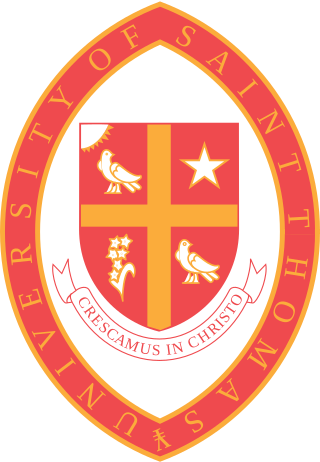
Texas Woman's University (TWU) is a public coeducational university in Denton, Texas, with two health science center-focused campuses in Dallas and Houston. While TWU has been fully co-educational since 1994, it is the largest state-supported university primarily for women in the United States. The university is part of the Texas Woman's University System. It offers undergraduate and graduate degree programs in 60 areas of study across six colleges.

The Houston Museum District is an association of 21 museums, cultural centers and community organizations located in Houston, Texas, dedicated to promoting art, science, history, and culture.

The University of St. Thomas is a private Catholic university in Houston, Texas. It was founded by the Basilian Fathers in 1947 and is the only Catholic university in the Archdiocese of Galveston-Houston.

Southwestern University is a private liberal arts college in Georgetown, Texas. Formed in 1873 from a revival of collegiate charters granted in 1840, Southwestern is the oldest college or university in Texas. Southwestern offers 40 bachelor's degrees in the arts, sciences, fine arts, and music as well as interdisciplinary and pre-professional programs. It is accredited by the Southern Association of Colleges and Schools and the National Association of Schools of Music and historically affiliated with the United Methodist Church.

Yoshio Taniguchi is a Japanese architect best known for his redesign of the Museum of Modern Art in New York City, which was reopened November 20, 2004. Critics have emphasized Taniguchi's fusion of traditional Japanese and Modernist aesthetics. Martin Filler, writing in The New York Times, praised "the luminous physicality and calm aura of Taniguchi's buildings," noting that the architect "sets his work apart by exploiting the traditional Japanese strategies of clarity, understatement, opposition, asymmetry and proportion." "In an era of glamorously expressionist architecture," wrote Time critic Richard Lacayo, MoMA "has opted for a work of what you might call old-fashioned Modernism, clean-lined and rectilinear, a subtly updated version of the glass-and-steel box that the museum first championed in the 1930s, years before that style was adopted for corporate headquarters everywhere."

The Tokyo National Museum or TNM is an art museum in Ueno Park in the Taitō ward of Tokyo, Japan. It is one of the four museums operated by the National Institutes for Cultural Heritage, is considered the oldest national museum and the largest art museum in Japan. The museum collects, preserves, and displays a comprehensive collection of artwork and cultural objects from Asia, with a focus on ancient and medieval Japanese art and Asian art along the Silk Road. There is also a large collection of Greco-Buddhist art. As of April 2023, the museum held approximately 120,000 Cultural Properties, including 89 National Treasures, 319 Horyuji Treasures, and 649 Important Cultural Properties. As of the same date, the Japanese government had designated 902 works of art and crafts as National Treasures and 10,820 works of art and crafts as Important Cultural Properties, so the museum holds about 10% of the works of art and crafts designated as National Treasures and 6% of those designated as Important Cultural Properties. The museum also holds 2,651 cultural properties deposited by individuals and organisations, of which 54 are National Treasures and 262 are Important Cultural Properties. Of these, 3,000 cultural properties are on display at one time, with each changing for between four and eight weeks. The museum also conducts research and organizes educational events related to its collection.

The Seoul Arts Center is an arts complex in Seocho District, Seoul, South Korea. It consists of five main buildings: the Opera House, with three auditoriums; the Music Hall, with two concert halls; the Hangaram Art Museum; the Hangaram Design Museum; and the Seoul Calligraphy Art Museum. The Opera House is built in a shape that resembles the traditional Korean bamboo hat called gat.

The Asia Society is a 501(c)(3) organization that focuses on educating the world about Asia. It has several centers in the United States and around the world. These centers are overseen by the Society's headquarters in New York City, which includes a museum that exhibits art from countries in Asia and Oceania.

The Kyoto National Museum is one of the major art museums in Japan. Located in Kyoto's Higashiyama ward, the museum focuses on pre-modern Japanese and Asian art.

The Houston Theater District, a 17-block area in the heart of Downtown Houston, Texas, United States, is home to Houston's nine professional performing arts organizations, the 130,000-square-foot (12,000 m2) Bayou Place entertainment complex, restaurants, movies, plazas, and parks. More than two million people visit the Houston Theater District annually.

The Museum of Fine Arts, Houston (MFAH), is an art museum located in the Houston Museum District of Houston, Texas. With the recent completion of an eight-year campus redevelopment project, including the opening of the Nancy and Rich Kinder Building in 2020, it is the 12th largest art museum in the world based on square feet of gallery space. The permanent collection of the museum spans more than 5,000 years of history with nearly 80,000 works from six continents. In 2023, the museum received over 900,000 visitors, making it the 20th most-visited museum in the United States.
Fayez Shalaby Sarofim was an Egyptian Coptic-American heir to the Sarofim family fortune, a fund manager for three Dreyfus family stock funds, the largest shareholder of Kinder Morgan and part owner of the NFL team Houston Texans.

The architecture of Houston includes a wide variety of award-winning and historic examples located in various areas of the city of Houston, Texas. From early in its history to current times, the city inspired innovative and challenging building design and construction, as it quickly grew into an internationally recognized commercial and industrial hub of Texas and the United States.

The Museum of Arts and Design (MAD), based in Manhattan, New York City, collects, displays, and interprets objects that document contemporary and historic innovation in craft, art, and design. In its exhibitions and educational programs, the museum celebrates the creative process through which materials are crafted into works that enhance contemporary life.

The Hobby Center for the Performing Arts is a theater in Houston, Texas, United States. Opened to the public in 2002, the theater is located downtown on the edge of the Houston Theater District. Hobby Center features 60-foot-high (18 m) glass walls with views of Houston's skyscrapers, Tranquility Park and Houston City Hall. The Hobby Center is named for former Texas lieutenant governor and Houston businessman, William P. Hobby, Jr., whose family foundation donated the naming gift for the center. The center replaced the former Houston Music Hall and Sam Houston Coliseum.

The National Museum of Modern Art, Tokyo, also known as MOMAT, is the foremost museum collecting and exhibiting modern Japanese art. The museum, in Chiyoda, Tokyo, Japan, is known for its collection of 20th-century art and includes Western-style and Nihonga artists. It has a branch, the National Crafts Museum, in the city of Kanazawa.

The culture of San Antonio reflects the history and culture of one of the state's oldest and largest cities straddling the regional and cultural divide between South and Central Texas. Historically, San Antonio culture comes from a blend of Central Texas and South Texas (Southwestern) culture. Founded as a Spanish outpost and the first civil settlement in Texas, San Antonio is heavily influenced by Mexican American culture due to Texas formerly being part of Mexico and, previously, the Spanish Empire. The city also has significant German, Anglo, and African American cultural influences. San Antonio offers a host of cultural institutions, events, restaurants and nightlife in South Texas for both residents and visitors alike.

The modern Qatari art movement emerged in the mid-20th century, as a result of the new-found wealth acquired from oil exports and the subsequent modernization of Qatari society. Because of Islam's non-inclusive stance of depictions of sentient beings in visual arts, traditional figurative art historically played an insignificant role in the country's culture. Other visual art forms such as calligraphy, architecture, and textiles were more highly regarded in Qatari tradition.
Yoshirō Taniguchi was a Japanese architect. He was born in the city of Kanazawa, Ishikawa Prefecture, Japan. He was a graduate of Tokyo University Department of Architecture and professor at Tokyo Institute of Technology from 1929–1965. As an architect, he created over 50 buildings and 10 memorials and participated in many professional activities as a statesman of Japanese modern architecture. “Yoshirō Taniguchi must be regarded as one of the most widely known, and, in the best sense, popular architects in Japan. Taniguchi is also well known for his writings and has made a name for himself as a designer of tombs, monuments and memorials which are all exquisite in themselves and suited to their surroundings.”.
Christopher Binyon Sarofim is an American businessman and fund manager.




















